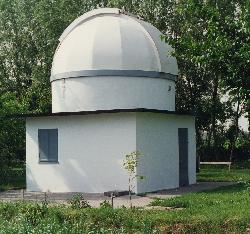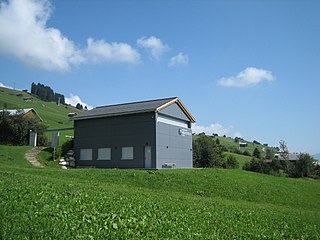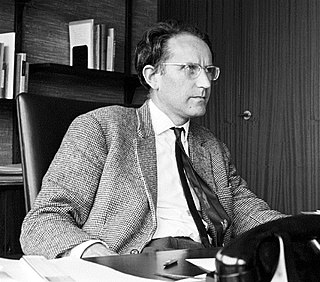The Minor Planet Center (MPC) is the official body for observing and reporting on minor planets under the auspices of the International Astronomical Union (IAU). Founded in 1947, it operates at the Smithsonian Astrophysical Observatory.
William Kwong Yu Yeung is a Hong Kong-born, Canadian amateur astronomer with telescopes based in the United States.
Vittorio Goretti was an Italian amateur astronomer and a discoverer of minor planets at his observatory in Pianoro, on the outskirts of Bologna, Italy.
C. Michelle Olmstead is an American astronomer, asteroid discoverer and computer scientist.
Masayuki Yanai is a Japanese astronomer. He is a prolific co-discoverer of minor planets. One of his co-discoveries is the dark, inner main-belt asteroid 3915 Fukushima. He retired from docent for astronomy at Sapporo Science Center.
Marco Cavagna was an Italian amateur astronomer.
Giovanni de Sanctis is an Italian astronomer and discoverer of minor planets at the Osservatorio Astronomico di Torino in Turin, Italy. His name is sometimes spelt DeSanctis, particularly in the Minor Planet Circulars. The Minor Planet Center credits him with the discovery of 42 numbered minor planets, most of which he discovered at ESO's La Silla site in northern Chile in the early 1980s.
The Uppsala–DLR Asteroid Survey is an astronomical survey, dedicated for the search and follow–up characterization of asteroids and comets. UDAS puts a special emphasis on near-Earth objects (NEOs) in co-operation and support of global efforts in NEO-research, initiated by the Working Group on Near-Earth Objects of the International Astronomical Union (IAU), and the Spaceguard Foundation. UDAS began regular observations in September 1999, with some test runs during 1998. Discoveries of NEOs are reported to the Minor Planet Center (MPC).

Bassano Bresciano is a comune in the province of Brescia, in Lombardy. As of 2011 Bassano Bresciano had a population of 2,237.

Višnjan Observatory is an astronomical observatory located near the village of Višnjan in Croatia. It is headed by Korado Korlević, a prolific astronomer and discoverer of minor planets. In 2009, the Višnjan observatory moved to Tičan and received the obs. code L01 on 5 October 2017.

The Sternberg Astronomical Institute, also known as GAISh (ГАИШ), is a research institution in Moscow, Russia, a division of Moscow State University. The institute is named after astronomer Pavel Karlovich Shternberg. It was founded in 1931, on the site of the observatory established by the university in 1831.
113390 Helvetia (provisional designation 2002 SU19) is a background asteroid from the inner regions of the asteroid belt, approximately 2.2 kilometers (1.4 miles) kilometers in diameter. It was discovered on 29 September 2002, by Swiss astronomer Markus Griesser at the Eschenberg Observatory in Winterthur, near Zürich, Switzerland. The presumed stony Florian asteroid was named after the Swiss national symbol, Helvetia.
2363 Cebriones is a large Jupiter trojan from the Trojan camp, approximately 84 kilometers in diameter. It was discovered on 4 October 1977, by astronomers at the Purple Mountain Observatory in Nanking, China. The dark D-type asteroid is one of the 40 largest Jupiter trojans and has a rotation period of 20 hours. It was named after Cebriones, Hektor's charioteer from Greek mythology.
1845 Helewalda is a carbonaceous Eoan asteroid in the outer regions of the asteroid belt, approximately 20 kilometers in diameter. It was discovered by Swiss astronomer Paul Wild at Zimmerwald Observatory near Bern, Switzerland, on 30 October 1972. The asteroid was named after Helen Gachnang, a friend of the discoverer.
1844 Susilva, provisional designation 1972 UB, is a stony Eoan asteroid from the outer region of the asteroid belt, approximately 22 kilometers in diameter. It was discovered on 30 October 1972, by Swiss astronomer Paul Wild at Zimmerwald Observatory near Bern, Switzerland, and later named after a schoolfriend of the discoverer.

The Mirasteilas Observatory is an astronomical observatory in Falera in the canton of Grisons in Switzerland. With its 90-centimeter telescope it is the largest publicly accessible observatory in Switzerland.
Hubelmatt Observatory is an astronomical observatory in Lucerne, Switzerland, billeted at the city's Hubelmatt West School. Built in 1979, it is operated by the Astronomical Society of Lucerne.
Robert K. Heuberger was a Swiss real estate entrepreneur, patron of the arts and an author under the pseudonym Victor Vermont.
Observations of minor planets as well as comets and natural satellites of the Solar System are made by astronomical observatories all over the world and reported to the Minor Planet Center (MPC), a service of the International Astronomical Union. The MPC maintains a data base that stores all observations submitted by these registered observatories. An astrometric record consists of the position, brightness and timestamp of an observed object, besides additional information. The database contains more than 200 million records gathered over the past two centuries.

Marcel Golay was a Swiss astronomer, professor at Geneva University and the eighth director of the Geneva Observatory from 1956 to 1992. Golay was a member of the International Astronomical Union and president of several of its commissions including "Stellar Classification" and "Astronomical Photometry and Polarimetry". In 1991, University of Basel awarded him an honorary professorship. Asteroid 3329 Golay is named after him.





